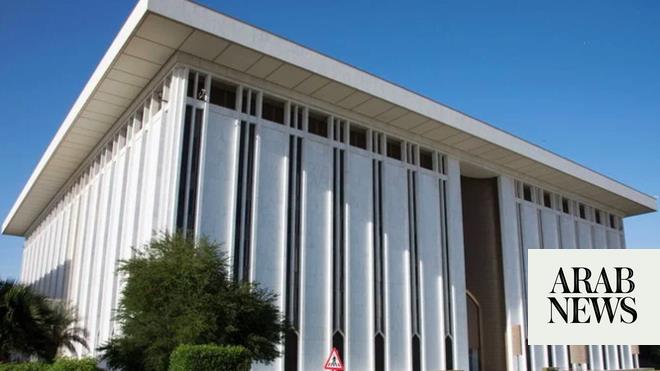
RIYADH: Saudi Arabia’s benchmark interest rate, held at 6 percent since July last year, has been lowered to 5.5 percent following a 50-basis-point cut announced by the Kingdom’s central bank.
This move aligns with the US Federal Reserve’s recent policy shift, which lowered interest rates by the same amount on Wednesday to a target range of 4.75-5 percent. It marks a shift in monetary policy after two years of rate hikes aimed at curbing inflation.
Gulf Cooperation Council central banks, including Saudi Arabia, followed suit as their currencies are pegged to the US dollar.
Anuj Goel, senior executive officer at Century Private Wealth, told Arab News: “The rate cut injects a shot of adrenaline into Saudi Arabia’s non-oil sectors. Construction and services are well-positioned to benefit from the influx of cheaper credit, which could significantly boost the Kingdom’s diversification efforts.”
He added: “Vision 2030, Saudi Arabia’s ambitious plan for a post-oil economy, might gain an unexpected boost from this monetary easing, potentially further accelerating non-oil activities that align with the Vision 2030 objectives.”
Lower interest rates are expected to relieve pressure on businesses and households with existing loan facilities, boosting domestic spending and improving corporate cash flow.
In a statement the central bank, also known as SAMA, said: “In line with its objective of preserving monetary stability, SAMA has decided to reduce the rate of Repurchase Agreement by 50 basis points to 5.50 percent, and the rate of Reverse Repurchase Agreement by 50 basis points to 5 percent.”
This is the first rate cut in over four years, reflecting progress on inflation and a reassessment of economic risks.
The policy shift could rejuvenate corporate activities and lending, particularly in the real estate sector, which has already seen substantial growth in Saudi Arabia.
As global economic conditions change, GCC countries could leverage their resources and capital to drive internal growth.
With lower borrowing costs, there is potential for investment in infrastructure, technology, and innovation — areas critical to the long-term diversification goals under Saudi Vision 2030.
This initiative aims to reduce the region’s dependence on oil revenues while strengthening Saudi Arabia’s position as a hub for innovation and sustainable development.
Lower rates are expected to have a significant impact on corporate lending. Saudi businesses, especially those in capital-intensive sectors like real estate, construction, and infrastructure, stand to benefit from cheaper credit, enabling more aggressive expansion and investment.
This is crucial as the Kingdom continues to invest in large-scale projects such as NEOM, the Red Sea Project, and other key initiatives under Vision 2030.
For Saudi banks, the rate cut presents both opportunities and challenges. Lower rates typically encourage more borrowing, potentially driving growth in lending portfolios, particularly in the real estate sector, where demand for housing has surged, fueled by a young population and urbanization trends.
“The real estate market, which has seen a 5 percent price increase since 2020, could see further growth due to lower interest rates. As Riyadh attracts more expatriates, the housing market might experience accelerated growth, fueled by the availability of cheaper credit,” Goel said.
The sector could receive a further boost as lower interest rates make mortgages and property financing more affordable for consumers.
While a rate cut can stimulate lending, it also compresses profit margins banks earn from loans. According to recent SAMA data, banks posted record-high profits of SR7.83 billion ($2.1 billion) in July, a 23 percent increase year on year.
The Dubai-based asset and wealth manager also cautioned that the combination of rate cuts and ongoing economic stimulus could spark inflationary pressures, particularly in the housing sector, thereby adding complexity to Saudi Arabia’s economic landscape.
GCC rate decision
Following the US Federal Reserve’s decision on Sept. 18, central banks in the UAE and Bahrain also lowered their interest rates by 50 basis points.
Qatar took a slightly different approach, cutting its deposit, lending, and repo rates by 55 basis points.
Meanwhile, Kuwait, which pegs its currency to a basket rather than solely to the US dollar, opted for a more modest reduction, trimming its discount rate by 25 basis points.
These coordinated moves reflect the GCC"s alignment with global monetary trends while balancing local economic considerations.
Gulf countries generally did not require high interest rates compared to the US due to relatively stable inflation rates, often at or below 2 percent.
As the US Federal Reserve begins its rate-cutting cycle, many economists view this as beneficial for the Gulf region.
Lower rates in the US can help ease funding pressures, particularly as the region faces a weaker oil-price outlook.
Reduced interest rates in the Gulf can support investment programs and alleviate financial strains from lower oil revenues, aiding in managing economic development and infrastructure projects.












